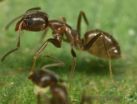(Press-News.org) Researchers from North Carolina State University have found that one of the most aggressive invasive ant species in the United States – the Argentine ant – appears to have met its match in the Asian needle ant. Specifically, the researchers have found that the Asian needle ant is successfully displacing Argentine ants in an urban environment, indicating that the Asian needle ant – with its venomous sting – may be the next invasive species to see a population boom.
In the world of invasive species, the Argentine ant (Linepithema humile) is a success story. Its aggressive, territorial behavior and ability to create huge "supercolonies" – consisting of thousands of queens and millions of workers – have enabled the Argentine ant to spread across the United States, displacing native species and changing ecosystems to suit its needs. No other ant species had been seen successfully pushing back – until now.
In 2008, while watching a supercolony of Argentine ants in an urban environment, former NC State Ph.D. student Dr. Eleanor Spicer Rice noticed that Asian needle ants (Pachycondyla chinensis) were living and working in the area. This was surprising because Argentine ants normally do not tolerate any other ant species in their territory, so Spicer Rice decided to investigate further.
Over the next four years, Spicer Rice found that Argentine ants appeared to ignore Asian needle ants, and the Asian needle ants took advantage of the situation to displace a significant portion of the Argentine ant population. In 2008, Argentine ants had populations in 99 percent of the sites within the study area, while only 9 percent of the sites were home to Asian needle ant populations. By 2011, Argentine ants were found in only 67 percent of the sites – while the Asian needle ants had expanded to occupy 32 percent of the sites. The two ant species shared 15 percent of the sites in common.
"This is the first time we've seen another ant species take territory from Argentine ants," says Spicer Rice, lead author of a paper on the research.
The researchers think that the Asian needle ant's ability to tolerate cooler temperatures may play a significant role in its ability to push out Argentine ants. During cold weather, both ant species become fairly dormant and cease reproducing, limiting their activity and driving their populations down. However, the Asian needle ants become active again much earlier – beginning to reproduce and build new nests in Argentine ant territory as early as March, while the Argentine ants remain inactive until late April or early May. "The Asian needle ants essentially get a head start," Spicer Rice says.
"If the Asian needle ant is effective at displacing a dominant species – and it is – then it could be the next major invasive ant species," says Dr. Jules Silverman, a professor of entomology at NC State and co-author of the paper.
"The Asian needle ant is moving into forests and urban environments at the same time," Spicer Rice says. "And because it is active at cooler temperatures, it could move into a very broad range of territory." The Asian needle ant has already been found in areas ranging from Alabama to New York City to Oregon.
The rise of the Asian needle ant is bad news. Asian needle ants have venomous stings, which can cause allergic reactions in some humans. Asian needle ants also appear to be driving out native ant populations in forests – including native species that play important roles in ecosystem processes, such as dispersing seeds.
INFORMATION:
The paper, "Propagule pressure and climate contribute to the displacement of Linepithema humile by Pachycondyla chinensis," was published online Feb. 8 in PLOS ONE. The research was supported by the Blanton J. Whitmire Endowment at NC State. Spicer Rice and Silverman are currently working on a paper that addresses why the Argentine ants are not attacking the Asian needle ants.
Researchers find Asian needle ants displacing other aggressive invaders
2013-02-11
ELSE PRESS RELEASES FROM THIS DATE:
Online or off, bullying proves harmful
2013-02-11
EAST LANSING, Mich. — Children who are bullied online or by mobile phone are just as likely to skip school or consider suicide as kids who are physically bullied, according to a study led by a Michigan State University criminologist.
The findings, published in the International Criminal Justice Review, suggest parents, school officials and policymakers should consider bullying experiences both on and offline when creating anti-bullying policies and procedures.
"We should not ignore one form of bullying for the sake of the other," said Thomas Holt, associate professor ...
Study shows progesterone shots do not reduce preterm delivery in twin pregnancies
2013-02-11
In a study to be presented on February 14 between 8 a.m. and 10 a.m. PST, at the Society for Maternal-Fetal Medicine's 33rd annual meeting, The Pregnancy Meeting ™, researchers will report findings that suggest that 17P, a form of progesterone, is not effective in preventing preterm birth among women with twin pregnancies — and may possibly be harmful.
While 17P (17 alpha-hydroxyprogesterone caproate) has been shown to prevent premature delivery among about one-third of women with a singleton pregnancy who have experienced a prior preterm delivery, this latest research ...
Rice University lab shows how blood vessels regroup after stroke
2013-02-11
By thinking of cells as programmable robots, researchers at Rice University hope to someday direct how they grow into the tiny blood vessels that feed the brain and help people regain functions lost to stroke and disease.
Rice bioengineer Amina Qutub and her colleagues simulate patterns of microvasculature cell growth and compare the results with real networks grown in their lab. Eventually, they want to develop the ability to control the way these networks develop.
The results of a long study are the focus of a new paper in the Journal of Theoretical Biology.
"We ...
Presence of intra-amniotic debris a risk for early preterm birth in first pregnancy
2013-02-11
In a study to be presented on February 14 between 8 a.m. and 10 a.m. PST, at the Society for Maternal-Fetal Medicine's annual meeting, The Pregnancy Meeting ™, in San Francisco, California, researchers will report findings suggesting an increased risk of early (less than 35 weeks) preterm birth when intra-amniotic debris is present in nulliparous women with a short cervix. The babies born to women with debris had worse outcomes than those born to women without debris, likely due to the earlier delivery.
The multicenter study, presented by Dr. George Saade for the Eunice ...
Can simple measures of labile soil organic matter predict corn performance?
2013-02-11
Organic matter is important for soil health and crop productivity. While an indicator of soil quality, a lot of organic matter is in extremely stable forms, and the nutrients in such forms are difficult for plants to use. The active, labile fraction, however, is a modest but important part of the organic matter.
"The labile fraction is small – usually less than 20 or even 10 percent, depending on how you define it," explains Steve Culman, lead author of a study published online Feb. 8 in Agronomy Journal. "But it is where a lot of the action happens. It's where soil nutrients ...
Study finds planned C-sections provide no advantage over planned vaginal birth of twins
2013-02-11
In a study to be presented on February 14 between 8 a.m., and 10 a.m. PST, at the Society for Maternal-Fetal Medicine's annual meeting, The Pregnancy Meeting ™, in San Francisco, researchers will report findings that suggest that planned birthing of twins at 32-38 weeks by cesarean section does not decrease perinatal or neonatal death compared to planned vaginal birth.
This randomized study The Twin Birth Study: a multicenter RCT of planned cesarean section and planned vaginal birth for twin pregnancies 320 to 386/7 weeks, should help women understand that a planned vaginal ...
Study suggests genetic predisposition to brain injury after preterm birth is sex-specific
2013-02-11
In a study to be presented on February 14 between 1:15 p.m., and 3:30 p.m. PST, at the Society for Maternal-Fetal Medicine's annual meeting, The Pregnancy Meeting ™, in San Francisco, researchers will report that variation in a gene involved in inflammation is associated with developmental problems after preterm birth in females, but not males.
This randomized study, Sex-specific genetic susceptibility to adverse neurodevelopmental outcome after early preterm birth, may improve understanding of how developmental problems occur after preterm birth and may help identify ...
Study suggests tightening up of criteria for definition of intrauterine growth restriction
2013-02-11
In a study to be presented on February 14 between 1:15 p.m., and 3:30 p.m. PST, at the Society for Maternal-Fetal Medicine's annual meeting, The Pregnancy Meeting ™, in San Francisco, researchers will report that the practice of using an arbitrary Estimated Fetal Weight (EFW) less than the 10th centile may not be an efficient practice for defining true Intrauterine Growth Restriction (IUGR).
The study was conducted by the Perinatal Ireland Research Consortium, a nationwide collaborative research network comprising of the seven largest academic obstetric centers in Ireland. ...
Policy changes in elective delivery proven successful
2013-02-11
In a study to be presented on February 14 between 1:15 p.m., and 3:30 p.m. PST, at the Society for Maternal-Fetal Medicine's annual meeting, The Pregnancy Meeting ™, in San Francisco, California, researchers will present data showing changes in elective delivery policy have been successful in reducing elective deliveries prior to 39 weeks.
Due to the troubling trend of elective delivery and induction, significant attention has been paid to the neonatal benefits of reducing elective deliveries before 39 weeks, both on the national and institutional level. Elective delivery ...
Better outcome for frozen embryo replacement vs IVF
2013-02-11
In a study to be presented on February 14 between 1:15 p.m., and 3:30 p.m. PST, at the Society for Maternal-Fetal Medicine's annual meeting, The Pregnancy Meeting ™, in San Francisco, California, researchers will present findings showing perinatal outcomes of frozen/thawed embryo replacement (FER) have better outcomes compared to fresh in vitro fertilization (IVF), but worse outcomes compared to the non-IVF general population.
The study collected data from all IVF treatments in Denmark, Norway and Sweden from 1984 – 2007, then cross-linked with the Nordic Medical Birth ...

